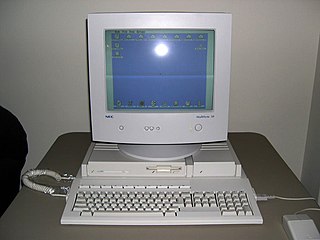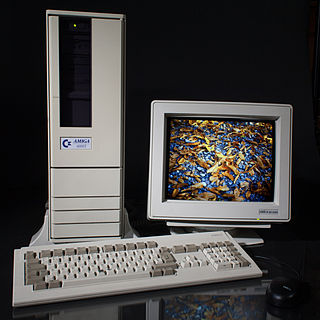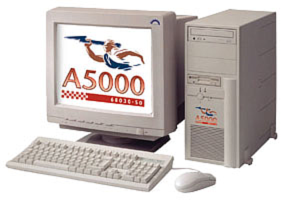
Amiga is a family of personal computers introduced by Commodore in 1985 and produced until 1996. The original model is one of a number of mid-1980s computers with 16- or 16/32-bit processors, 256 KB or more of RAM, mouse-based GUIs, and significantly improved graphics and audio compared to previous 8-bit systems. These systems include the Atari ST—released earlier the same year—as well as the Macintosh and Acorn Archimedes. Based on the Motorola 68000 microprocessor, the Amiga differs from its contemporaries through the inclusion of custom hardware to accelerate graphics and sound, including sprites and a blitter, and a pre-emptive multitasking operating system called AmigaOS.

The Amiga 500, also known as the A500, was the first popular version of the Amiga home computer, "redefining the home computer market and making so-called luxury features such as multitasking and colour a standard long before Microsoft or Apple sold these to the masses." It contains the same Motorola 68000 as the Amiga 1000, as well as the same graphics and sound coprocessors, but is in a smaller case similar to that of the Commodore 128.

The Amiga 1000, also known as the A1000, is the first personal computer released by Commodore International in the Amiga line. It combines the 16/32-bit Motorola 68000 CPU which was powerful by 1985 standards with one of the most advanced graphics and sound systems in its class. It runs a preemptive multitasking operating system that fits into 256 KB of read-only memory and was shipped with 256 KB of RAM. The primary memory can be expanded internally with a manufacturer-supplied 256 KB module for a total of 512 KB of RAM. Using the external slot the primary memory can be expanded up to 8.5 MB.

The Amiga 600, also known as the A600, and full title Commodore Amiga 600, is a home computer introduced in March 1992. It is the final Amiga model based on the Motorola 68000 and the 1990 Amiga Enhanced Chip Set. A redesign of the Amiga 500 Plus, it adds the option of an internal hard disk drive and a PCMCIA port. Lacking a numeric keypad, the A600 is only slightly larger than an IBM PC keyboard, weighing approximately 6 pounds (2.72kg). It shipped with AmigaOS 2.0, which was considered more user-friendly than earlier versions of the operating system.

The Amiga 3000, or A3000, is a personal computer released by Commodore in June 1990. It is the successor to the Amiga 2000 and its upgraded model Amiga 2500 with more processing speed, improved graphics, and a new revision of the operating system.

The Amiga 2000 (A2000) is a personal computer released by Commodore in March 1987. It was introduced as a "big box" expandable variant of the Amiga 1000 but quickly redesigned to share most of its electronic components with the contemporary Amiga 500 for cost reduction. Expansion capabilities include two 3.5" drive bays and one 5.25" bay that could be used by a 5.25" floppy drive, a hard drive, or CD-ROM once they became available.

The Atari Falcon030, released in 1992, is the final personal computer from Atari Corporation. A high-end model of the Atari ST line, the machine is based on a Motorola 68030 CPU and a Motorola 56001 digital signal processor, which distinguishes it from most other microcomputers of the era. It includes a new VIDEL programmable graphics system which greatly improves graphics capabilities.

The X68000 is a home computer created by Sharp Corporation. It was first released in 1987 and sold only in Japan.

The PowerBook G3 is a series of laptop Macintosh personal computers designed, manufactured, and sold by Apple Computer from 1997 to 2001. It was the first laptop to use the PowerPC G3 (PPC740/750) series of microprocessors, and was marketed as the fastest laptop in the world for its entire production run. The PowerBook G3 was succeeded by the PowerBook G4.

The Atari TT030 is a member of the Atari ST family, released in 1990. It was originally intended to be a high-end Unix workstation, but Atari took two years to release a port of Unix SVR4 for the TT, which prevented the TT from ever being seriously considered in its intended market.
DeskStation Technology was a manufacturer of RISC-based computer workstations intended to run Windows NT. DeskStation was based in Lenexa, Kansas.
This is a list of models and clones of Amiga computers.

The Macintosh Quadra 605 is a personal computer designed, manufactured, and sold by Apple Computer from October 1993 to July 1996. The model names reflect a decision made at Apple in 1993 to follow an emerging industry trend of naming product families for their target customers – Quadra for business, LC for education, and Performa for home. Accordingly, the Performa 475 and 476 was sold in department stores and electronics stores such as Circuit City, whereas the Quadra was purchased through an authorized Apple reseller.
The Amiga is a family of home computers that were designed and sold by the Amiga Corporation from 1985 to 1994.
AmigaOS is the proprietary native operating system of the Amiga personal computer. Since its introduction with the launch of the Amiga 1000 in 1985, there have been four major versions and several minor revisions of the operating system.
The Macintosh LC 500 series is a series of personal computers that were a part of Apple Computer's Macintosh LC family of Macintosh computers, designed as a successor to the compact Macintosh family of computers for the mid-1990s mainstream education-market. The all-in-one desktop case is similar to the then recently introduced Macintosh Color Classic, but the LC 500 series is considerably larger and heavier due to its larger screen and a bulging midsection to house the larger electronics, including a 14" CRT display, CD-ROM drive, and stereo speakers.

Minimig is an open source re-implementation of an Amiga 500 using a field-programmable gate array (FPGA).

The Amiga 4000T, also known as A4000T, is a tower version of Commodore's A4000 personal computer. Using the AGA chipset, it was originally released in small quantities in 1994 with a 25 MHz Motorola 68040 CPU, and re-released in greater numbers by Escom in 1995, after Commodore's demise, along with a new variant which featured a 50 MHz Motorola 68060 CPU. Despite the subsequent demise of Escom, production was continued by QuikPak in North America into at least 1998.

The Amiga 1200, or A1200, is a personal computer in the Amiga computer family released by Commodore International, aimed at the home computer market. It was launched on October 21, 1992, at a base price of £399 in the United Kingdom and $599 in the United States.

The Power A5000 was a planned Amiga clone computer, announced by German DCE Computer Service GmbH and British Amiga peripherals manufacturer Power Computing Ltd.. It was one of the first Amiga clone computers announced after Gateway purchased the Amiga in 1997.















